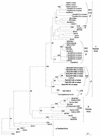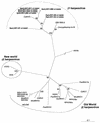Novel gamma-1 herpesviruses identified in free-ranging new world monkeys (golden-handed tamarin [Saguinus midas], squirrel monkey [Saimiri sciureus], and white-faced saki [Pithecia pithecia]) in French Guiana
- PMID: 12885928
- PMCID: PMC167222
- DOI: 10.1128/jvi.77.16.9099-9105.2003
Novel gamma-1 herpesviruses identified in free-ranging new world monkeys (golden-handed tamarin [Saguinus midas], squirrel monkey [Saimiri sciureus], and white-faced saki [Pithecia pithecia]) in French Guiana
Abstract
The recent finding of a novel Epstein-Barr virus-related lymphocryptovirus (CalHV-3) in a captive colony of common marmoset (Callithrix jacchus) in the United States modifies the view that the host range of lymphocryptovirus is restricted to humans and Old World primates. We investigated the presence of Epstein-Barr virus-related viruses in 79 samples of New World monkeys caught in the wild, including six species of the Cebidae family and one of the Callitrichidae, living in the rain forest of French Guiana. Using a degenerate consensus PCR method for the herpesvirus DNA polymerase gene, we identified three novel lymphocryptoviruses from golden-handed tamarin (Saguinus midas) of the Callitrichidae family and squirrel monkey (Saimiri sciureus) and white-faced saki (Pithecia pithecia) of the Cebidae family. With the CalHV-3 strain, these three novel viruses constitute a well-supported phylogenetic clade in the Lymphocryptovirus genus, which is clearly distinct from the lineage of Old World lymphocryptovirus, hosted by catarrhine monkeys and humans. In tamarins, the prevalence of the novel lymphocryptovirus was more than 50%, indicating that it circulates well in the wild population, perhaps due to specific ecoethological patterns such as confrontations and intergroup migration. The detection and partial molecular characterization of the polymerase gene of three novel Gamma-1-Herpesvirinae from New World monkeys caught in the wild clearly indicate that free-ranging populations of platyrrhine are natural hosts of lymphocryptoviruses. Further characterization of these novel viruses will provide new insight not only into the origin and evolution of Gammaherpesvirinae but also into their pathogenicity.
Figures


References
-
- Albrecht, J. C., and B. Fleckenstein. 1990. Structural organization of the conserved gene block of Herpesvirus saimiri coding for DNA polymerase, glycoprotein B, and major DNA binding protein. Virology 174:533-542. - PubMed
-
- Daniel, M. D., A. Karpas, L. V. Melendez, N. W. King, and R. D. Hunt. 1969. Isolation of herpes-T virus from a spontaneous disease in squirrel monkeys (Saimiri sciureus). Arch. Gesamte Virusforsch. 22:324-331. - PubMed
Publication types
MeSH terms
Substances
Associated data
- Actions
- Actions
- Actions
- Actions
- Actions
- Actions
- Actions
- Actions
LinkOut - more resources
Full Text Sources
Miscellaneous

